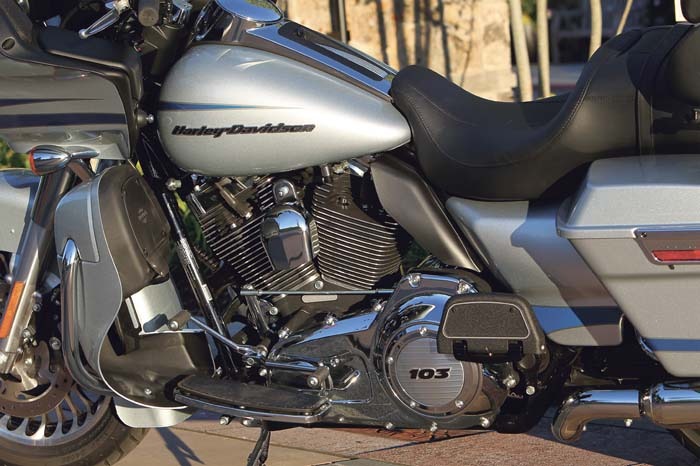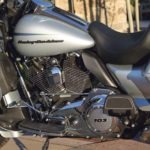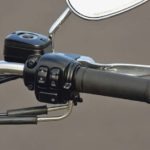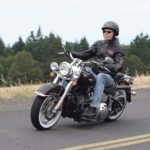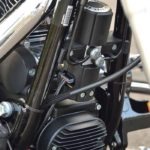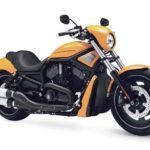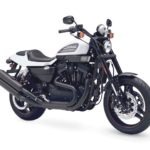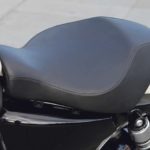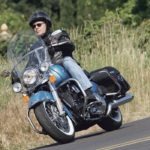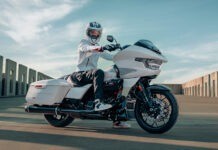The long and the short of it
Leaner lineup woos Boomers and beginners
Newberg, Ore., July 21—The current mantra susurrating through the corridors and cubicles of Juneau Avenue is “multi-generational cycle of growth” and it summarizes tidily the task at hand for The Motor Company at this critical juncture as it tailors its development and marketing strategy to the changing demographics of the market. As explained in the press materials provided at the introduction of the Company’s 2011 collection, the goal of that approach is “long-term sustainable growth on both sides of the age distribution curve—Boomers and new audiences,” and judging by the new model offerings as well as the changes made to some existing models this year, that’s not mere idle talk.
The objective, after all, is to keep the aging base of faithful Bar & Shield adherents happy while simultaneously appealing to a new generation of riders—one whose notions of what’s hot and what’s cool are not necessarily aligned with those of their parents or, these days, grandparents. A tough balancing act, that, but one that Milwaukee’s apparently pulling off, proudly touting the fact that Harley-Davidsons are, in fact, the most popular street bikes among buyers in the 18-to-35 age bracket. We doubtless have the whole Dark Custom campaign to thank in large part for that, particularly the slew of sinister Sportster models—theNightster, Iron 883 and Forty-Eight—that have emerged in the recent past, and which comprise fully half of theSportster platform offerings for 2011.
Joining that platform this year and superseding the XL 883L Low is the new XL 883L SuperLow, which shares its alphabet soup nomenclature with the outgoing model, but not much else. It’s designed as a true newbie-friendly entry-level mount and we’ll discuss it at length directly, but let’s begin our examination of what’s new for 2011 at the other end of the age distribution bracket, the Boomer-beloved Tourer models, where the changes are significant and many.
Have it your way
Officially, there is one new model joining the Tourer platform for 2011—the FLTRU Road Glide Ultra, a fully-outfitted bagger that takes up where the discontinued FLT Road Glide left off in 2009 and piles on the traveling amenities. The model sports a Tour-Pak with plush passenger backrest and 80-watt surround-sound speaker setup like its established stablemate, the Electra Glide Ultra Classic. It also shares with the 2011 Electra Glide models a new touring seat that’s been reshaped with a deeper pocket and narrower front portion for easier operator leg reach to the pavement. (That seat actually became standard equipment on the Electra Glides in January, midway through the 2010 production cycle.) Additionally, the new Ultra improves upon the touring prowess of the departed Road Glide with a windscreen that’s been angled up to reduce the buffeting wind effects of its predecessor. Most significant of all, however, is the Ultra’s Twin Cam 103-inch motor, a potent powerplant boasting 10 percent more torque than the TC 96, and one that previously came into production usage on the Trikes and last year’s Electra Glide Limited. That model and that motor impressed us mightily, proving nearly impossible to lug and returning exceptional fuel economy, and we weren’t alone in our appreciation as the Limited went on to prove hugely popular on the sales floor.
Happily, the TC 103 is also the motor powering the 2011 FLHRC Road King Classic, and it’s offered as an option on two other models, the Street Glide and Road Glide Custom. It’s all part of a $1,995 upgrade package dubbed the Power Pak, and bundles anti-lock brakes, Smart Security and bold “103”-emblazoned derby cover and air cleaner along with the bigger mill. That’s an unprecedented bit of accessorizing for Milwaukee and, it could be argued, actually expands the Tourer platform by two unofficial new models—we’d call them the FLHX and FLTC Limited models. Why not?
In addition to the optional Power Pak, the “Custom Tourer” subset of the platform represented by the Street Glide and Road Glide Custom—virtually identical machines aside from their fairings—get some other changes as well. For one thing, the 2-into-1 exhaust system introduced last year as a styling exercise failed to resonate with the public, and in response to that feedback the familiar 2-1-2 setup has been fitted instead for 2011. New seats come to both models, again reshaped with the narrower front section for inseam-friendliness.
The remaining Touring models, the FLHTC Electra Glide Classic, FLHTCU Ultra Classic and FLHR Road King, continue to run TC 96 motors exclusively. You can’t get the Power Pak. You can, however, get the $1,195 Security Package which consists of the ABS and Smart Security upgrades, but not the TC 103.
Softail sweeteners
The Softail platform also offers the Security Package on all models except the Cross Bones, and it’s noteworthy here because it puts an ABS on the Softies for the first time. That innovation took some doing in order to preserve the sanitary looks of the machines, and entailed using smaller components stashed here and there around the bike, the only visible one being the front brake hydraulic control unit tucked in above the voltage regulator on the front of the frame.
The Softails also get a set of redesigned hand controls that have a lot going for them. For one thing, they perform more functions than before, with the starter switch now doing additional duty as the hazard light switch by pressing it up instead of down, and the horn button similarly doubles as the odometer reset, again by pressing it up. There’s an additional advantage to the new controls in their relative simplicity, using fewer and smaller wires, which makes changing the handlebar easier. In use, the new switches have a more immediate and positive feel than the ones they replace. They’re pretty much instantly likable, and the odometer reset button relocation is especially functional.
That’s the good news on the Softail front for 2011, but there’s also some sad news and it’s the departure of the FXSTC Softail Custom from the lineup, and that departure marks the end of an era. The FXST designation has now completely disappeared from the Harley alphabet after an iconic 26-year run that began with the original Softail. The remaining models are the FXCWC Rocker C, FLSTC Heritage Classic, FLSTN Deluxe, FLSTF Fat Boy, FLSTFB Fat Boy Lo, and FLSTSB Cross Bones.
All quiet on the Dyna front
Likewise, the only real news from the Dyna platform is a bit of a historical bummer as well, as the FXD Super Glide has also been shown the door, which is particularly poignant since 2011 would have been the model’s 40th anniversary. Some solace can be taken in the continued presence of the FXDC Super Glide Custom, which, after all, remains truer to the original FX styling-wise and is the direct descendent of the 35th anniversary Super Glide model. The more practical upshot of the FXD’s departure is the increase in the admission price to the Big Twin club from that model’s $11,999 sticker to the $12,999 sticker on the Super Glide Custom and FXDB Street Bob. (If that’s a deal breaker for you, act now while 2010 FXD supplies last.) Filling out the Dyna roster are the FXDWG Wide Glide and FXDF Fat Bob.
And then there were two
The 1250cc Revolution-powered VRSC platform now offers the aforementioned Security Package as an option on both the VRSCF V-Rod Muscle and VRSCDX Night Rod Special. The Night Rod Special also gets a wild new palette of available colors with ghost-flamed racing stripes to supplement its existing selection of, essentially, black. And following what seems to be a pattern this year, the actual VRSCAW V-Rod—the swoopy-piped vestige of the original groundbreaking design—has been dropped from the roster, paring it down to just the two models.
Return of the Trikes
Nothing much to report from this platform. Both the FLHTCUTG Tri Glide Ultra Classic and FLHXXX Street Glide Trike remain for 2011, but beyond that it’s crickets in three-wheeler land. Make no mistake, though, this platform will figure more and more into Milwaukee’s plans for the Boomers as time rolls on and inflicts its ravages.
Achieving a new Low
Numerically, it’s the Sportster platform that got the most attention this year, as two new models have joined the family: the XL 883L SuperLow and the XR 1200X. The existence of the latter model—easily the most aggressive street machine in Milwaukee’s stable—was actually old news by the time of the model launch, having debuted in the U.S. in early June and in Europe last year. A review of the bike ran in these pages previously, but to briefly recap what we reported, the X improves on the 2010 XR 1200 it supplants by adding fully adjustable Showa suspension components fore and aft, as well as Nissin brakes with full floating rotors. A blacked-out powertrain further distinguishes the new model, as does a $1,000 steeper list price of $11,799.
And that brings us to the most interesting development of all in the 2011 lineup, the new SuperLow, a model that underscores just how serious Milwaukee is about expanding their appeal to a younger, more inexperienced—or even unexperienced—audience. The SuperLow is loosely based upon last year’s 883 Low, but only loosely. The challenge here was transforming that model into something not merely purposed as an entry-level gateway drug to the Harley habit, but purposed as well as a legitimate beginner’s bike (albeit one with an unusually large displacement for the role). That transformation was no mean feat and involved, for starters, a complex reformulation of steering head rake, triple tree offset, wheel and tire size and design, suspension components and final drive ratio. Specifically, the head rake was increased to 31 degrees while the actual front fork rake remains at 29.6 degrees; the rear wheel grew from 16″ to 17″ and the front wheel shrank from 19″ to 18″, and new Michelin Scorcher “11” radial tires were fitted to both; longer shocks were installed adding 0.75″ of travel to the rear end, and the transmission pulley grew by one tooth giving the bike a 2.34:1 final drive.
That collection of alterations results in a mount with a longer wheelbase, an inch more trail, taller gearing and diminished cornering clearance—all of which may strike you as counterintuitive when creating a ride for neophytes. For that you’d think they’d emphasize quick first gear engagement and quick handling, but there’s method in their madness when you mull it over and consider that straight-line stability is enhanced by the increased trail and taller gearing means less jumpy throttle response at slow speeds. The trade-off for the loss of cornering aptitude on the SuperLow is significantly improved seat comfort and suspension bounce—two areas that palpably sweeten the basic ride experience for the new operator for whom, let’s face it, aggressive cornering ability is not a big priority. It’s a ride the company characterizes as “confidence inspiring” and we’d go along with that assessment.
Ergonomically, the SuperLow improves upon its precursor with the addition of new higher, wider, more reachable handlebars, and even while adding additional padding to the solo seat, the saddle height of the SuperLow remains, at 25.5″, about the same as on the Low. (Keeping it down there while adding padding to the seat was achieved by moving the ECM from beneath it.) Functionally, there are other improvements including the use of a 4.5-gallon fuel tank in place of the previous 3.3-gallon cell, and the use of those new wheels and low-profile radial tires that, combined, weigh in at five pounds less than the setup on the Low, thus reducing unsprung weight.
All of that massaging has resulted in a decidedly unique Sportster, and one well-suited to its stated purposes, but it comes at a price. The $7,999 list on the SuperLow, while the lowest of the 2011 models, is a grand more green than the 2010 Low commanded.
Besides the eclipse of the XR 1200 and XL 883L Low, both of which have been handily replaced, the Sportster platform loses one other bike, the XL 1200C Custom, and with it the last Sportster model equipped with both forward controls and a two-up saddle. Only the XL 1200X Forty-Eight still runs feet-forward, and only the XL 1200L Low still accommodates a passenger. Rounding out the stable are the XL 1200N Nightster and XL 883N Iron 883.
(Our thanks to Harley-Davidson Communications operative Jen Gruber for her service as our SuperLow photo model for this article.)


